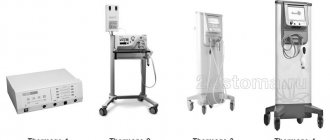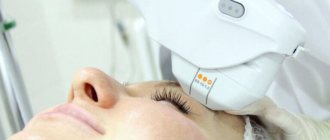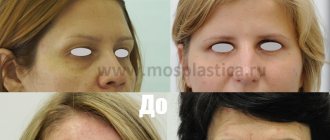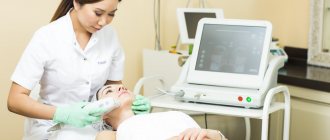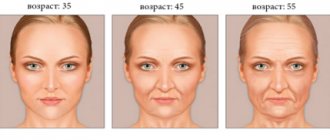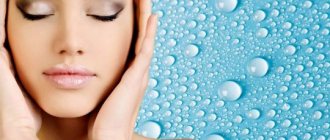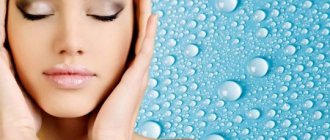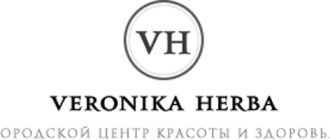Correction methods
The only way to completely remove jowls is through surgery. There are several methods for dealing with sagging cheek skin. Let's look at the main ones:
- skin tightening;
- SMAS-lifting (tightening the muscular aponeurotic layer);
- MASC-lifting (method of influencing the muscular-ligamentous system);
- space lifting (tightening the muscle layer of the middle and lower third of the face).
To understand the advantages and disadvantages of each method, you need to understand the anatomy of the face, the location of muscles and the causes of aging.
Facial anatomy and causes of jowls
The soft tissues of the face consist of 5 layers:
- Leather. In the mid-20th century, it was generally accepted that the skin sagged. Therefore, for the purpose of rejuvenation, it was she who was tightened. The result was short-lived.
- Subcutaneous fat layer. It includes 2 main components: connective tissue and fat itself. The thickness of this layer varies in different areas and is not the same in different patients. With age, the amount of fat decreases, and the remaining fat clumps into lumps and sank, thus forming jowls and a number of other defects (bags under the lower eyelid, etc.).
- Musculoaponeurotic layer or SMAS. As we age, muscles stretch and sag along with fat. Therefore, tightening the skin alone does not give the desired result. A lasting effect can only be achieved by correcting the entire layer, including skin, muscles, fat and connective tissue. This kind of lift is called
- Connections and spaces. The connection of soft tissues to bones (to the skeleton) is made using ligaments. However, the ligaments are not distributed evenly throughout the face. They are located locally in several zones. In the spaces between them, the muscle layer is directly connected to the next fifth layer. In these places, the muscles can move freely along with the skin, which is how facial expressions appear on the face. Ligaments, unlike muscles, do not sag over time, so when looking at yourself in the mirror, it is not difficult to detect the transition between these layers.
- Periosteum and deep fascia. These are tissues fused to bone. They do not affect the formation of jowls.
The next layer is the skeleton. It also undergoes changes over time, its volume decreases.
Thus, as a result of aging, the lower jaw shrinks and the cheek muscles stretch, sagging along with the fat. Which leads to the formation of jowls.
Jowl contouring with Juvederm Voluma filler
Juvederm Voluma is an American-made gel filler that is popular all over the world. Removing jowls on the face in honey is carried out using this drug because it is safe for health and highly effective. It includes:
- hyaluronic acid - slows down aging, saturates the skin with moisture;
- lidocaine - makes the procedure painless;
- phosphate buffer - has an anti-inflammatory effect.
Removing jowls on the face using filler gives a noticeable effect in one procedure. The results of Juvederm Voluma injections last up to two years.
How is space lifting done?
Space lifting allows you not to move the entire SMAS layer, but to work only in spaces where there are no ligaments that increase with age. Suturing the spaces also allows you to remove jowls. In this case, the ligaments are also cut, and the SMAS returns to its original position. In this case, a minimal incision is made on the SMAS layer itself, without which the surgeon cannot do his work. After all the manipulations are completed, the SMAS is simply sutured and the excess skin is excised. To perform a space lift, access is also required through an incision along the ear and above.
The advantages of the method include fixation of spaces, which eliminates the possibility of relapse. While with SMAS the spaces remain stretched, only the muscular aponeurotic layer is tightened. Therefore, jowls may appear again as the space continues to stretch. However, the space method, unlike a full-fledged SMAS, does not make it possible to tighten the neck muscles.
Plastic surgeon Andrey Leonidovich Ishchenko talks about lifting the oval face. Where are the chin folds, popularly called jowls, and what do they consist of?
Jowls
are an anatomical formation consisting mainly of fatty tissue and skin. They are located in the lower zone of the face (face oval), as if bordering the chin on both sides. This is a muscleless area that lacks dense anatomical structures, which is what causes sagging. With age, the muscular-apponeurotic structures surrounding this anatomical formation become flabby and no longer retain fat. The same anatomical feature makes it difficult to correct jowls, because loose and porous structures are difficult to fix and move.
According to many anatomists and surgeons, the formation of jowls is partly due to the formation of Bichat's lump, which is a very complex and extremely variable anatomical structure: it can go from the temporal region, moving into the space located under the entire zygomatic arch, occupying the entire cheek (its central part ), take part in the nasolabial folds, in the formation of soof zones (that is, it is an integral part of the premalar fat body), and there is also a pharyngeal spur. Many anatomists believe that hernias of parabulbar (periorbital) tissue are also part of Bisha's lump.
Lump of Bisha
– a structure that is a cluster of large fatty packets (like a bunch of large grapes): amorphous, almost avascular (there are a few vessels in the shell of each packet). The pretentiousness of its anatomical form was revealed by the outstanding French anatomist Marie François Xavier Bichat. The structure of Bisha's lump differs from person to person. Previously, it was believed that it was present only in children and then atrophied. Nothing like this. Women almost always have it, in one form or another. In men, it happens that there is no single lump, only fragments.
Figure 1a
Figure 1b
It is completely impossible to remove Bisha's lump, since it is almost entirely penetrated by the branches of the facial nerve. Only that part of the buccal fragment is removed in which there are no neurovascular formations. We do this with great care, knowing exactly what can be removed. When correcting jowls, we resort to removing only that part of the Bisha's lump that is involved in the formation of these chin folds.
So, correction of chin folds (jowls) comes down to correctly determining which tissues formed this fold: skin, subcutaneous tissue, fatty body of the cheek, or all these components combined.
SMAS facelift
There is an opinion that jowls can be removed well with the help of a SMAS lift with a standard incision around the ear. However, eliminating jowls only by stretching the muscular aponeurotic system is ineffective. On the contrary, when tightening the SMAS, this fold may worsen. SMAS is an aponeurotic system that does not participate in the formation of mental folds, but is one of the walls of the gap (posterior), through which fatty tissue “falls out”, forming jowls (Figure 1b). When the SMAS structure is pulled, this gap expands, and the pressure on the Bisha lump increases due to the tension of the SMAS, and the loss of fatty tissue becomes even more unhindered.
Figure 2a
To avoid such aggravation, local plication is used - sutures that allow you to “straighten” the prolapsed tissue and close the anatomical gap through which it prolapses. To do this, first disconnect the anterior fascial wall of this gap (fascia of the muscle that depresses the angle of the mouth), which goes from the skin directly to the bone of the mental part of the lower jaw.
Figure 2b
If this separation is not made and the anterior wall of the jowl remains in place, then, having moved upward and backward, the entire structure described above will have more defined contours.
The effectiveness of this method of eliminating the chin fold is very high. It can be used as a separate operation to improve the contours of the lower area of the face, or as part of a complex of manipulations performed during SMAS lifting.
rehabilitation period for these operations is the same as for any other “open” (non-endoscopic) anti-aging surgical interventions on the face.
Figure 3
This is not a public offer! There are contraindications. Before use, consultation with a specialist is required.
Endoscopic and minimally invasive methods for eliminating jowls
Correction of mental folds can also be performed using endoscopic or minimally invasive surgery. These methods are used when it becomes clear that the skin does not participate in the formation of jowls, that is, there is no excess of it that needs to be removed. The incision, in this case, goes either inside the auricle (behind the tragus of the ear), or behind the auricle in the transitional fold (in the region of its lower pole). The incision size is 1.5-3 cm. Through these incisions we perform a wide dissection of the tissue in layers. During endoscopic or minimally invasive operations, we separate the anatomical adhesion between the skin and the mental part of the lower jaw (as described earlier and shown in Figure 2b), and then we plicate the mental fold, as described earlier (only now under endoscopic control), thus flattening it .
The threads that we use for this, that is, we make a power loop, are not absorbable. This is a synthetic polymer - POLYPROPYLENE (by the way, threads from the same polymer, only shorter, are also used with the method described above). The polypropylene thread is very strong, although we need it to last for about six months. In general, polypropylene is one of the most bio-indifferent materials that remains in human tissues for life. The thread can also be removed: its function is completed after six months - the tissues have grown together and are fixed in a new position forever.
Disadvantage of the method
is that it has a rather limited range of applications. After all, the situation when the chin folds are formed only due to deep structures and do not have excess skin is quite rare.
The effectiveness of the technique is great if the patient is initially selected correctly. The longevity of the effect also depends on this.
Early rehabilitation period : 2-4 weeks. Final effectiveness occurs by 4 months after surgery.
Figure 4
This is not a public offer! There are contraindications. Before use, consultation with a specialist is required.
Threadplasty of jowls
This technique differs from endoscopic and minimally invasive in that during its implementation we perform tunnel construction blindly, and the adhesion of threads to tissues also occurs blindly. Naturally, we are not talking about disconnecting the front wall of the gate of the fallen fiber, or about other methods of treating this zone. And yet, in the initial stages of the formation of chin folds, this technique has good effectiveness! When removing jowls using threads, the threads must be attached to the mastoid process, located behind the ear. If the thread is simply left in soft tissues, it is completely ineffective. Whatever the thread is made of, it must be attached to the periosteum. The operation itself is carried out as follows: a 1 cm incision is made behind the ear, and a blind tunnel is made under the skin to the chin fold. We pass the thread into it up to this fold, poke the needle out into the skin without removing the thread, then with the second tip, by touch, we pick up the layer of overhanging tissue that makes up the jowl, and return the needle to its original position at the beginning of the tunnel, thus forming a thread loop in deep tissues. We stretch this loop, moving the fabric upward. We fix (sew) it to the periosteum of the mastoid process.
Figures 5a, 5b, 5c, 5d
Threads can be passed through tissues without preparing them, that is, piercing them in thickness, but we prefer to form a tunnel, because when it grows together, tissues moved upward and fixed with a thread loop grow to the walls of the tunnel, which is a more reliable and durable fixation than the thread itself.
The early rehabilitation period is 2-3 weeks. Swelling when installing threads is very moderate. But bruises can be quite pronounced, because in the tunnel it is impossible to blindly stop the bleeding of small vessels, but pronounced hematomas are also not observed due to the low traumatic nature of the method. The final effect occurs by 2 months after surgery.
Efficiency . This technique cannot be considered 100% effective. It solves the problem of overhanging fiber at a fairly young age. If there is sagging in other structures (muscles, fascia, skin), it cannot be used!
Jowl liposuction
It is used when we have clearly determined that the formation of the chin fold mainly involves subcutaneous fatty tissue, and not the spur of Bisha's lump. This is determined by a plastic surgeon by palpation. Of some signs, it can be noted that the subcutaneous fat deposit is denser to the touch than the fiber of the Bisha's lump, in addition, when the muscles that lower the corner of the mouth are tense, the folds formed by the Bisha's lump are aggravated, and those formed due to subcutaneous fat - slightly straightened out. If this differentiation is somehow complicated, which is extremely rare (especially if there have already been plastic surgeries in this area), then with the help of ultrasound it is possible to quite accurately determine which structures are involved in the formation of the mental fold. Liposuction of this area is most often performed through a small puncture behind the tragus of the auricle. Next, classic mechanical vacuum liposuction is performed in the jowl area.
If the nasolabial and chin folds form a single line, as if connecting with each other (this situation has its own name “MODEOLUS” - from the Latin mollusk), liposuction can be performed through a puncture near the wings of the nose and lipoaspiration can be performed on both the nasolabial and chin folds in a single field.
Effect . With an initially correct assessment of the situation (overhanging folds due to subcutaneous fat), the effect is persistent. Final effectiveness occurs by 2 months after surgery.
Rehabilitation period : swelling is moderate, bruising is minimal and their degradation occurs in 2-3 weeks.
High-frequency electrical reduction of jowls
This method turns out to be effective in the initial stages of jowl formation: the high-frequency method is aimed at creating a very high temperature in the problem area, about 50 degrees Celsius. Moreover, directly under the skin the temperature is 40-42 degrees, and when treating fiber and fascial structures it is 45-50 degrees. The principle of the technique is as follows: an electrode (needle) is inserted through a puncture in the corner of the mouth. It is carried out to the place where the fold overhangs, and in 2 layers: one layer is under the skin (with a lower temperature of exposure), and the other above the fascia is SMAS (hotter exposure). Under the influence of high frequency current, all the structures that make up the chin fold are “boiled.” This causes fatty tissue to melt and permanently reduces collagen fibers in the deep layers of the dermis and fascial structures. Subsequently, this area is scarred, that is, it acquires a deep scar density, leaving no traces on the surface of the skin!
Figure 6a
To perform this type of manipulation, specially designed electrode attachments for devices are used: “MARTHYN”, “SURGETRON”, “ASCLEPION” and others.
For uniformity of impact and maximum durability of the effect, the procedure must be repeated 2-3 times with an interval of 2-3 weeks. By the way, the entire face, or rather its most problematic areas, can be subjected to such treatment.
Rehabilitation period . For a period of 3-7 days, strips are glued to the treatment site to consolidate the result. The swelling can be quite pronounced and will persist for 7-10 days, and slight peeling of the skin is possible.
Efficiency . The planned tightening effect develops over the next 3-4 weeks. This technique is not effective for everyone: it is important to determine in advance the degree of age-related changes in the tissues of this area.
Figure 6b
This is not a public offer! There are contraindications. Before use, consultation with a specialist is required.
Lipofilling
Some surgeons even out jowls using lipofilling, filling the areas near the jowls with fat.
If the jowls have become prominent due to atrophy of the tissue in the chin area, lipofilling can be used to smooth out this area. The advantages of the technique are that the introduced fat cells are more stable compared to natural ones, because after their secondary engraftment, a dense shell is formed around each one, which also holds the rest of the tissue surrounding it. This is a good durable plastic material! Sagging is aggravated by fillers (gels), since they consist of water and additionally attract water to themselves, which makes the tissue heavier, while fat is light and floats.
Flaws . This technique has very limited indications, since the jowl area has an anatomy that is somewhat unsuitable for lipofilling. Injected along the lower contour of the face, fat visually makes the face heavier. And if jowls are formed due to an overhanging excess of fatty tissue, then lipofilling can only make them worse!
Rehabilitation period : swelling is moderate, bruising is minimal and their degradation occurs in 2-3 weeks. Engraftment of fat occurs within 1 to 3 months.
Chin implant placement
If mental folds are caused by an anatomically undeveloped or sloping chin, which happens quite often (this is an anatomical feature associated with the attachment of the ligamentous apparatus of the “gate” of the jowl), then installation of the implant has a positive effect on their elimination.
In the surgical technique, we dissect the anatomical fascial structures that form the mental folds, and, moving forward, they are smoothed.
The method has practically no disadvantages Sometimes it needs to be supplemented with high-frequency electrical reduction or RF lifting for a more pronounced cosmetic effect.
Efficiency . Even a small implant will help eliminate jowls. And this is an indisputable fact. Therefore, we often complement the SMAS lifting technique with implant placement.
Figure 7
This is not a public offer! There are contraindications. Before use, consultation with a specialist is required.
Rehabilitation period.
The fixing bandage is removed 10-11 days after surgery, then the swelling goes away within 2-4 weeks. Final aesthetic effectiveness occurs 2-4 months after surgery.
Therapeutic cosmetology: RF lifting
This technique is based on the fact that, passing through biological media (living tissues), the radio wave acts with its high temperature only on the dermis and hypodermis (layer of subcutaneous fat), that is, specifically on the skin areas responsible for the cosmetic effect, while the epidermis is the top layer of skin remains intact.
There are 2 types of devices (modes of influence): bipolar and monopolar. The mode is selected depending on the severity of age-related changes, tissue status (turgor, thickness, etc.). Today, the following devices created for this procedure are considered the most modern and effective: “ASCLEPION RF”, “SmartXide 2”, “Revital RF”, “Palomar” and others.
With bipolar exposure, a radio wave from one source collides with a simultaneously sent same radio wave from a second source. At the site of their collision, tissue heating occurs. Monopolar exposure uses the collision of radio waves with tissues, where they are heated from this collision. This increase in tissue temperature causes local, controlled inflammation, which leads to increased tissue production of all biologically active substances. At the same time, the pastiness (constant swelling) of the tissues goes away, and lymphostasis disappears due to increased blood circulation. In addition, after 2-3 months, during which 5 to 8 RF lifting sessions are performed (according to an individual scheme and power), the tissues of the treated area become denser and less porous, and therefore lose their ability to swell. And this is one of the persistent components of the cosmetic effect of RF lifting.
Rehabilitation period
practically absent. At most, slight peeling of the skin may appear. This is an ideal method for young women who are not yet candidates for plastic surgery and who, due to their work commitments, cannot endure a rather long period of postoperative rehabilitation.
Flaws
. There is always an effect, but partial effectiveness is the only side effect. This happens due to the fact that initially the cosmetologist incorrectly identifies the causes that form chin folds, overestimating the therapeutic methods of influencing them.
conclusions
It is difficult to take into account everything - tissue consistency, turgor, contractility and much more - but an experienced doctor can predict the effectiveness of a particular method by 80-90%!
There are many methods, but still, completely erasing the chin folds is a problem.
There are a number of patients in whom almost all of the listed methods of influencing the chin folds were used, and, as a result, a partial effect was obtained. It is, of course, quite visible, but not 100%. The only good news is that the number of these cases is much less than cases with a pronounced lasting cosmetic effect! To communicate with patients who have undergone facial rejuvenation, come to our forum, section Anti-aging surgeries
MASS-lifting
The technique that causes the most controversy is that it is ineffective for most patients. However, with certain deviations it also shows good results. Moreover, it cannot be called a full-fledged facelift.
During the MASC lifting procedure, the doctor makes an incision along the ear and higher along the hairline and pulls the SMAS through the resulting incision using threads. In this case, the muscular aponeurotic layer is not cut, but simply tightened. After the procedure, the SMAS is constantly in a tense position, and therefore quickly stretches again. In addition, with the introduction of thread lifting techniques without an incision, the relevance of this operation naturally came to naught.
Several years ago, a plastic surgeon from France proposed improving the MASC lifting method and using metal staples instead of threads. However, practice has shown that, under constant load, the staples partially unbend, and the facial tissues return to their original state.
How to choose a jowl correction method
The choice of technique should depend on the indications. However, in practice, the surgeon often offers a limited choice, since he does not know all the methods. Therefore, there are many legends among patients about the ineffectiveness of, for example, space lifting. However, in some cases this is indeed the case. Other specialists give information that the space method is too dangerous and traumatic, offering the MASC available to them, which rarely brings the desired result, since it is effective only at the very initial stage.
General recommendations for choosing a method:
- MASC can be used in the same cases as thread lifting.
- The space method is indicated for moderate jowls, when the neck is still in good shape.
- The SMAS lift is most effective for severe problems. However, everything must be done according to indications; you should not rush with heavy artillery if it is not yet necessary.
How to remove jowls and tighten the oval of the face
Jowl lifting is performed only after preparation. To identify contraindications, a cosmetologist examines the medical history, prescribes tests and allergy tests. Before contouring you need:
- exclude foods with high salt content,
- give up alcohol and nicotine,
- reduce physical activity and sports.
You must notify your doctor in advance about taking any medications. This will help eliminate unexpected reactions. Contour plasty of jowls is not performed if:
- pregnancy and lactation;
- inflammation at the sites of intended injections;
- exacerbation of chronic diseases.
Risks associated with a facelift
Women and men choosing a correction method are rightfully concerned about possible complications, primarily the risk of damage to the facial nerve. At the same time, fear is often whipped up by cosmetologists who persuade patients to use thread techniques available to them. In practice, nerve damage occurs, firstly, infrequently, and secondly, it is subject to correction, i.e. the nerve can simply be sewn together. Of course, not all doctors are proficient in this technique, so mistakes made by one specialist are most often made by another, more qualified one. In rare cases, stitching is not possible.
However, this is not the main difficulty in the work of an experienced cosmetic surgeon. The main thing is to determine the patient’s needs so that the aesthetic result does not disappoint. Since the likelihood of fatal complications is negligible.
